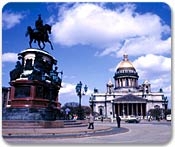
St. Petersburg St.
Petersburg
Determined
to give his country a Baltic port, Peter the Great
founded St. Petersburg in the Neva delta in 1703.
Over 40,000 peasants and Swedish prisoners of war
died during building work in the fetid bogland, but
in 1712 Peter declared the new city Russia's capital.
Wishing to create a Western-style city, he employed
the Italian architect Bartolomeo Rastrelli, whose
sumptuous buildings, including the Winter Palace,
set its elegance tone. Among the city's prominent
landmarks are the gilded spire and dome of the cathedrals
of St. Isaac and SS Peter and Paul. Dvortskaya Naberezhnaya
is lined with stately palaces and Nevskiy Prospekt
bustles with shops and café's. A boat trip along St,
Petersburg's canals is a highlight of any visit.
The
Hermitage
The
hermitage has an encyclopaedic collection of works
of art occupying a grand ensemble of buildings. The
most impressive part is Rastrelli's Baroque Winter
Palace (1754-62), built as the winter residence of
Tsarina Elizabeth. Its highlights are the Jordan Staircase,
the Small Throne Room and the Malachite Room. Catherine
the Great soon added the more intimate Small Hermitage,
but in 1771 she commissioned the Large Hermitage to
house her rapidly growing art collection. The theatre
was completed in 1787. The New Hermitage was built
between 1839 and 1851 in the reign of Nicholas I,
who opened the New and Large Hermitages in 1852 as
a public museum. Between 1918 and 1939, after the
establishment of Soviet power, the Winter Palace was
slowly incorporated into the Hermitage museum ensemble.
|

























